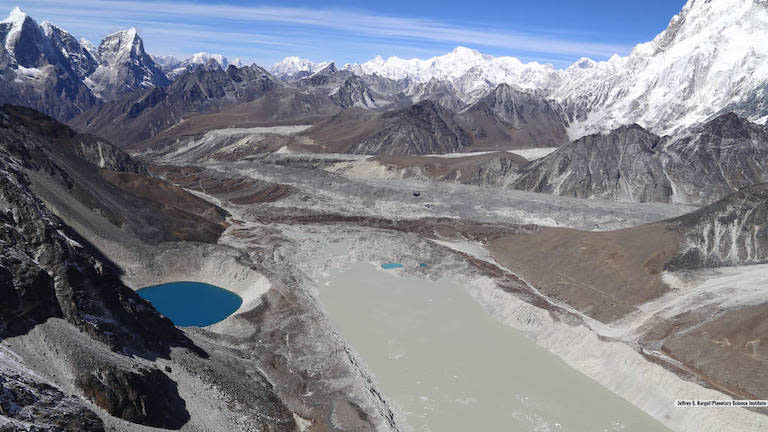Lakes formed from melting glaciers increase 50% in just 30 years, satellite survey finds

Melting glaciers have increased the volume of glacial lakes by 50% in just 30 years, researchers have found.
A study using 30 years of NASA satellite data showed how rapidly glacial lakes have expanded since 1990.
Glacial lake volumes worldwide now total 37.4 cubic miles, the researchers believe, and some could put local populations at risk from floods.
The study shows the impact of global temperatures on the world’s glaciers and provides scientists with a clearer picture of how much of this water has been stored in lakes.
Read more: Antarctic records hottest temperature ever
The findings were published in the journal Nature Climate Change.
“We have known that not all meltwater is making it into the oceans immediately,” said lead author Dan Shugar, of the University of Calgary in Canada.
“But until now there were no data to estimate how much was being stored in lakes or groundwater.”
Shugar and his colleagues initially aimed to use satellite imaging and other remote-sensing data to study two dozen glacial lakes in High Mountain Asia, the geographic region that includes the Tibetan Plateau and surrounding mountain ranges, including the Himalaya.
But the researchers used 250,000 scenes from NASA’s Landsat satellite missions to estimate the volume of glacial lakes worldwide.
“We wrote scripts in Google Earth Engine, an online platform for very large analyses of geospatial data, to look only at High Mountain Asia, and then decided to look at all glacial lakes in the world,” Shugar said.
Read more: Scientists drill into mysterious lake buried 3,500 feet under Antarctica
“From there, we were able to build a scaling relationship to estimate the volume of the world’s glacial lakes based on the area of this large population of lakes.”
Meltwater stored in this way can have a major impact on mountain communities downstream of these glacial lakes, the researchers warn.
“This is an issue for many parts of the world where people live downstream from these hazardous lakes, mostly in the Andes and in places like Bhutan and Nepal, where these floods can be devastating,” Shugar said.
“Fortunately, organizations like the United Nations are facilitating a lot of monitoring and some mitigation work where they’re lowering the lakes to try and decrease the risks.”
Read more: Melting snow in Himalayas drives growth of green sea slime visible from space
Earlier this year, satellite analysis found that 28 trillion tonnes of ice has disappeared from Earth’s surface since 1994.
Researchers from Edinburgh University, the University of Leeds and UCL analysed satellite surveys across the world - and found “staggering” ice loss.
Professor Andy Shepherd, of Leeds University, told The Guardian, “In the past researchers have studied individual areas – such as the Antarctic or Greenland – where ice is melting.
“But this is the first time anyone has looked at all the ice that is disappearing from the entire planet. What we have found has stunned us.”

 Yahoo News
Yahoo News 

